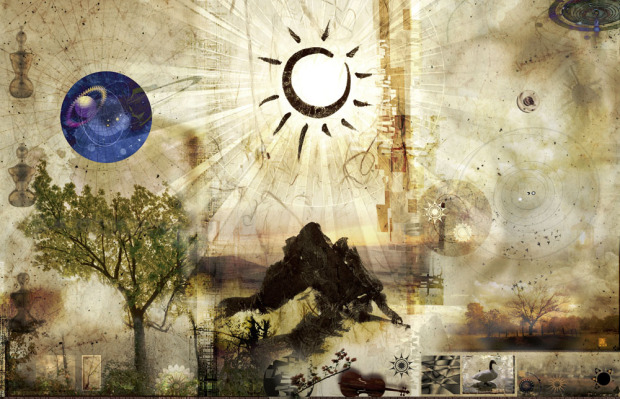Digital Alchemy Artist's Statement
Cosmographicon, 1998, archival ink jet print
Though commonly thought of as the ancient technology of conjuring gold, Alchemy can also be seen as a series of indecipherable recipes for the art of transmutation. As seen from our time, the symbols and arcane writings in the alchemical texts seem obscured in a fog of lost meaning and cultural distance. Yet they spark our imagination with the idea that if only one were to study them hard enough, a great secret might be revealed.
When assessing these prints, I want the viewer to feel this same emotion of baffled yearning. However, rather than hailing from the past, my work points to the enigma of our modern world. Using the modern technology of Digital Collage, I strive to present a series of images in which symbols and juxtapositions are arranged to elicit a sense of understanding that can be felt but not articulated.
Most of these pieces are steeped in layers—a quality that reflects my perception of a world layered in complexity. Human existence has evolved into a state of incredible sophistication. Everyday life now contains numerous levels of experience that encompass intellectual, cultural and technological perspectives. Over this, my mind will layer countless abstractions, interpretations, and emotions. Perhaps survival necessitates that I filter out the immensity of mystery in the universe around us. But once in a while, if I happen to glance out a car window at a speeding landscape, or notice the reflection on an ancient building, the enormity of mystery rushes back in. Then I feel as if we are all walking in a dream. It is in these moments that I glean the alchemical symbols that form the language of my art.

Pattern Cloud, 1997, archival ink jet print
For me, the evolution of the language of art—impressionism, cubism, collage, abstraction-- can be interpreted as an attempt by the creative mind to come to terms with this growing multiplicity of layers in our world. It is not just coincidence that the concept of layering forms the basis for the digital technology used to create these prints. I believe digital technology has become an essential instrument with which to continue this discussion of the phenomenon of modernity.
There is no common starting point for my work. The seed might be an emotion elicited by the texture of old parchment, a landscape I’ve photographed, or the memory of journey. From there I begin to compile related imagery and fairly soon a theme emerges. I then pursue all the layers of that theme that demand to express themselves. The piece usually contains a physical layer, something close to what we call reality. But the physicality of a thing is only the beginning of experience. I want to reveal hidden presence, to peel back the surface and expose forgotten or unnoticed connections. I find myself adding layers to make associations and juxtapositions—an old map on a landscape or dark gears clustered around the earth. Or perhaps I will create variations to form a dialectic—how many ways can you see a tree? Some of these images end up describing a place—as in the dry desert of Thirst, while others are about a concept—September Waters seeking to express the emotion of a season. Construction Zone reflects my feelings on the process of creation itself. Many of the pieces depict the influence of the future, some reveal the complex mechanisms of the present, most of them hint at a great legacy of the past.
Like the alchemistic totems of ancient times, each of these images can be thought of as a recipe for describing a mystery. I never expect to explain the mystery of our world, but if I can articulate a new thought, inspire a question, or elicit a recognized but indescribable emotion then I feel I have succeeded.
--Daniel Colvin, Seattle, 1998
Sun Mountain, 1998, archival inkjet print
